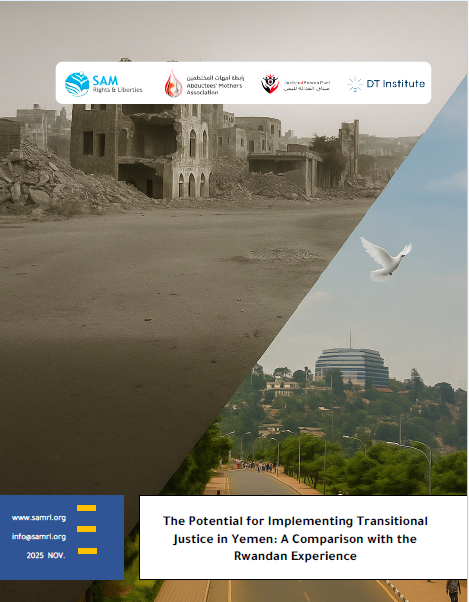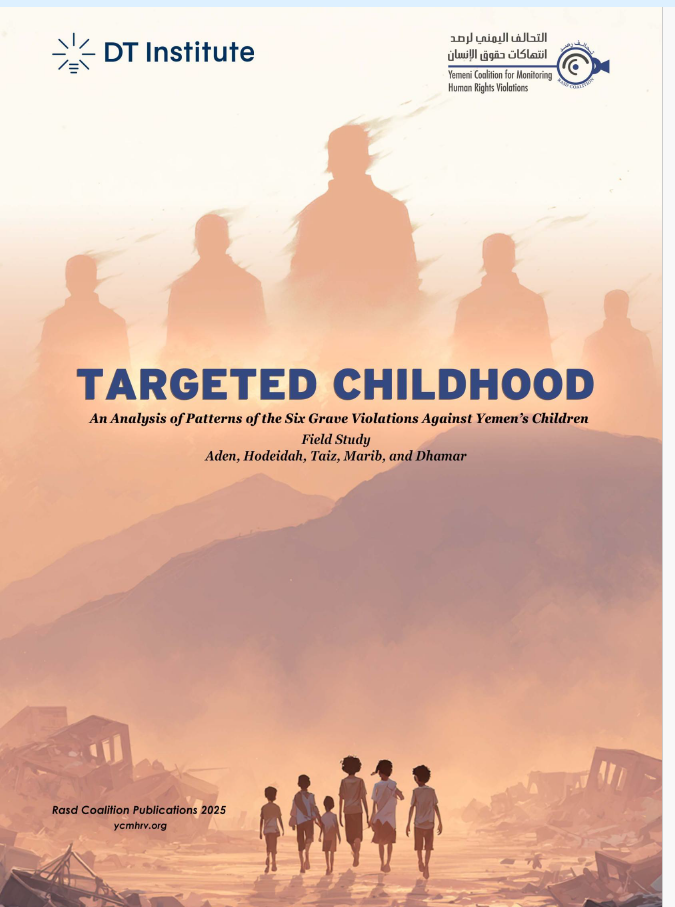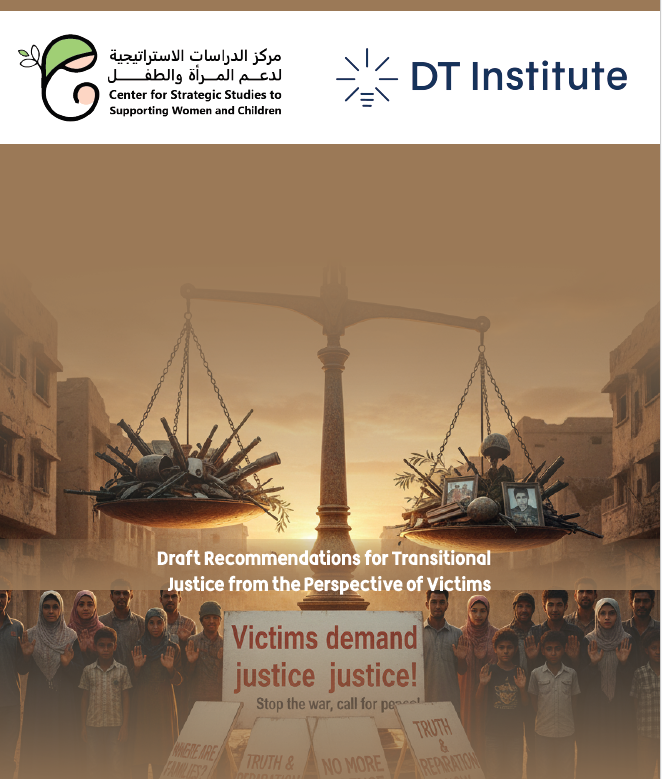1. Overview of the SPARK Program
In June 2025, five members of the Justice4Yemen Pact (J4YP), a coalition of 10 Yemeni civil society organizations, joined the SPARK team, composed of DT Institute and its local partners, the Abductees’ Mothers Association (AMA) and SAM for Rights and Liberties (“SAM”), to launch advocacy campaigns to complement and expand the geographic scope of restorative justice pilots and raising awareness initiatives in Taiz and Marib.
The pilots aim to foster reconciliation and resolve community-level public disputes that have caused human rights violations. While the advocacy campaigns focus on raising community awareness of transitional justice – its mechanisms, opportunities for engagement, and importance for sustainable peace in Yemen – enabling replication of reconciliation mechanisms and community involvement in national transitional justice processes.
This model was designed in response to the findings of The Path Towards Peace, a research study published by SPARK in April 2025. This study captured local understandings of transitional justice (TJ) across Yemen, revealing that 64.3 percent of community members prioritize reconciliation and war-ending efforts over retributive accountability. Moreover, it further revealed that 51 percent of the research sample had no knowledge of transitional justice at all – identifying a crucial need for education. Participants identified clear roles for civil society: initiating dialogue and reconciliation, offering legal and financial aid to victims, raising TJ awareness, and documenting violations.
To address these gaps, SPARK works to strengthen locally owned mechanisms of reconciliation that respond to community demands for peace over retribution. At the same time, the program builds resilience within divided communities, creating sustainable pathways for dialogue and conflict resolution. Through inclusive approaches, such as victim-centered advocacy campaigns and innovative cultural initiatives, like music for reconciliation, SPARK ensures that women, youth, and marginalized groups are not only participants, but central drivers of Yemen’s transitional justice journey. With donor support, these efforts can be scaled to reach more communities, ensuring that reconciliation and peace take root from the group up.
2. Initiative Spotlight: The Role of Tribal Customs in Promoting Transitional Justice
Across Yemen, especially in more rural areas that lack formal legal systems, tribal law is respected and used to resolve local disputes. This system includes complex structures with arbitration practices and appeal procedures, governed by tribal elders and sheiks. They handle cases spanning from personal injury to marriage and divorce, environment, and property disputes – covering various areas of traditional law.
In comparison to the traditional legal system, many claim that the Yemeni tribal systems are faster, more efficient, and more likely to produce verdicts that are understood and accepted by all parties. This is because of tribal law’s inherent reliance on community values and ownership. Tribal dispute resolution is rooted in consensus and relies on shared perceptions of honor, collective responsibility, and Yemeni tribal relations.
Similarly, effective transitional justice processes also require understanding, commitment, and reliance of shared community values and ownership. Transitional justice processes must be victim-and community-centered and led, ensuring that the needs of victims – and communities as collective victims – are addressed to enable sustainable peace.

Yemeni transitional justice must be implemented and sustained through initiatives that are tailored to the Yemen context. This includes tribal law and frameworks. Moreover, Yemeni transitional justice must operate in a way that is respected and embraced by victims and communities across the country to enable sustainable, whole-of-society change.
By embracing tribal law and frameworks for dispute resolution, transitional justice can harness this established, effective resolution system which fosters community ownership throughout Yemen, instead of re-creating the wheel.
Under The Role of Tribal Customs in Promoting Transitional Justice Initiative, J4YP partner, Marib Dam Foundation for Social Development (MDF), is working to bridge the gap between transitional justice and Yemeni tribal dispute resolution. MDF, through its publication, The Role of Tribal Customs in Promoting Transitional Justice, proposes a vision for integrating tribal customs with formal legal mechanisms to achieve accountability, reconciliation, and sustainable peace through Yemen’s transitional justice processes.
Drawing from field experiences in governorates such as Marib, Shabwa, and Taiz, the report analyzes and reveals how tribal mediations have resolved blood-feud cases, opened vital roads, and supported exchanges of prisoners of war (POWs). In exploring the compatibility between transitional justice processes and tribal practices, the paper analyzed the core principles of each system and their points of alignment and divergence.
Through this analysis, the study revealed important shared core principles, including reconciliation (sulh) and guarantees of non-repetition. Moreover, strong intersections were observed in the tangible implementation of both systems. These included the concepts of diyya or “blood money,” which refers to a form of financial reparations in Islamic law that is paid to the victim or his/her heirs in cases of homicide, bodily harm, or property damage.
MDF also revealed significant point of divergence through the study, emphasizing that these must be addressed to effectively integrate tribal customs into transitional justice processes. The most urgent points include the absence of formal documentation accompanying cases and conflict between some tribal customs and some universal human rights principles (such as, discrimination against minorities or mediation in serious criminal matters).
Upon detailed capturing, comparison, and analysis of both systems, the report concludes that transitional justice in Yemen cannot succeed if it ignores local tribal customs and practices, as long-standing pillars of social balance and dispute resolution. To support this crucial implementation, the report proposes recommendations and an implementation plan. The report is put forth as one of many initial actions of the plan. Further specific recommendations and actions included development of coordination models and a national reference guide on tribal customs aligned with transitional justice, as well as other initiatives designed to bring these two frameworks together.
4. Learning, Documentation, and Replication
To share the report’s key findings and engage key local and international change makers on the intersection between transitional justice and tribal customs, MDF launched the paper in a hybrid (online and in-person) event. The event was held in Marib and attended by over 78 individuals, including in-person and online attendees.
The symposium generated significant local interest with 68 in-person attendees, including 17 students from the Sharia, law, and political science divisions at the University of Sheba.
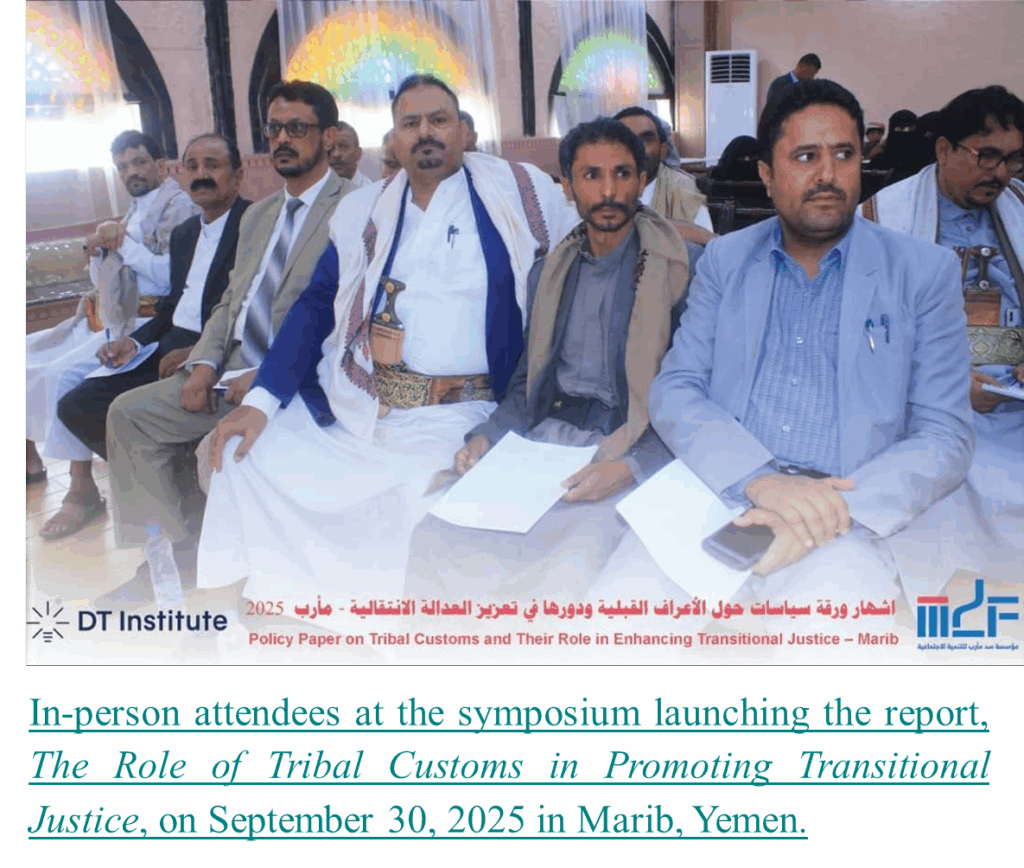
In-person attendees also included influential tribal leaders, civil society, victims, and human rights activists. Representatives of the local government , relevant authorities, and prominent political parties in Marib (including the Baath, Nasserist, Socialist, Solidarity, and Rashad parties) also attended in-person.
Online attendees numbered 10 and included representatives of national and international non-governmental organizations, alliances, and networks. These included the United Nations Development Programme (UNDP), UN Office of the Special Envoy of the Secretary-General for Yemen (OSESGY), the National Commission of Inquiry (NCI), Youth without borders organization and the Civil Rights and Constitutional Committee. The event was broadcast live on the local radio station Al-Etihadia FM, which has wide offline coverage reaching multiple cities, including Jawf.
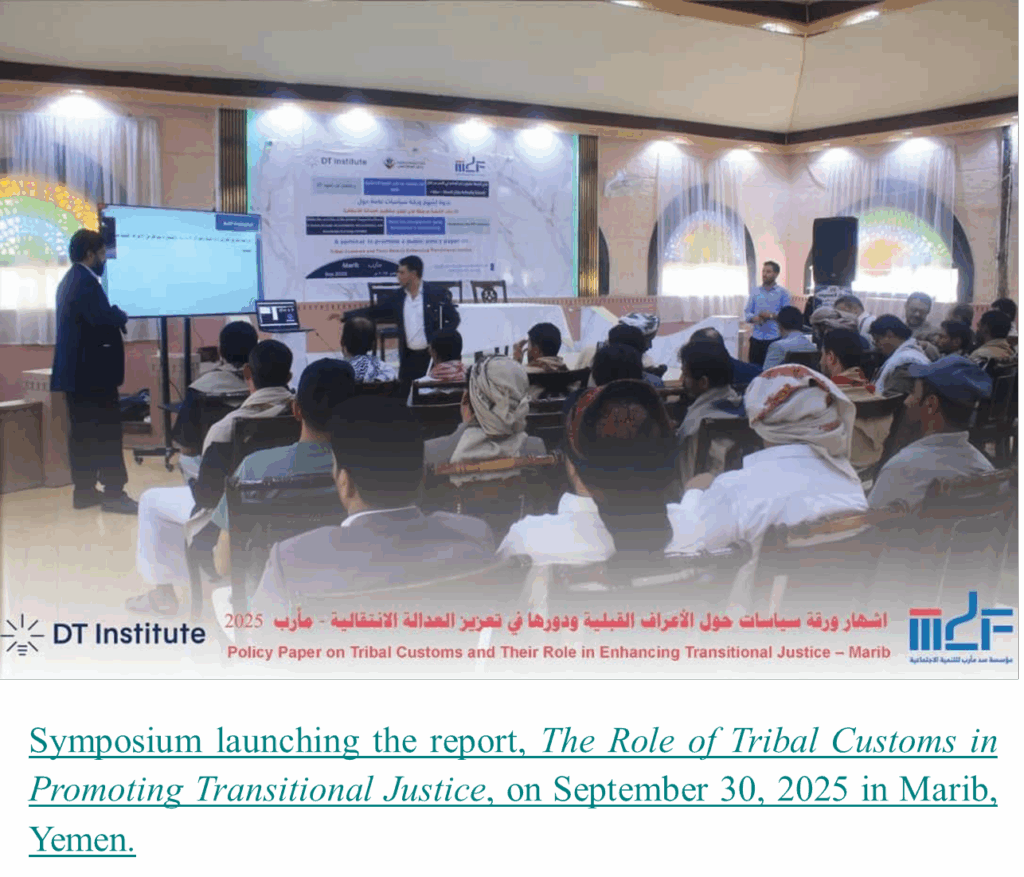
Within the webinar, these prominent speakers engaged in rich and lively discussion surrounding the findings. Discussions highlighted the critical role played by Yemen’s tribal mechanisms throughout the conflict — mediating ceasefires, facilitating prisoner exchanges, and maintaining community-level peace. The participants embraced the research’s conclusion that a transitional justice model grounded in local customs, Islamic values, and legal principles could offer a credible path toward reconciliation and sustainable peace.
Stakeholders, including UNDP, praised the study’s relevance and depth, stating: “We are interested in this topic and have developed related policies, but producing such a comprehensive study is truly valuable.”
In addition to the UNDP, 10 stakeholders reached out to MDF individually to express their strong interest and anticipation to read the full study. These included OSESGY, the Sana’a Center for Strategic Studies, IMKAN and the Deep Root Project, among other local initiatives, civil society, humanitarian workers, and lawyers.
💬 “I salute you for the valuable symposium that was implemented today. In terms of the topic and the beautiful presentation of the researcher, … and also in terms of managing the interventions and questions by the participants, live and on zoom as well. [We are] waiting for the paper – to be reviewed and benefited from.” – Najla Fadel, symposium participant and representative, Abductees’ Mothers Association
Victims’ representatives also expressed that the paper “represents their voices and helps them demand their rights.” Law and religious studies students who attended the symposium described the event as a significant learning opportunity, with one noting, “We need to integrate these topics into our academic curricula.”
💬 “The content of the paper is very important and directly related to our curriculum, and we hope that the content of this paper will be integrated into the curriculum for Sharia and law students, whether for Bachelor’s or Master’s level, or that awareness and introductory seminars or training programs will be adopted for what this paper deals with.” – Symposium participant and University of Sheba student.
International organizations also indicated the study’s value as a reference in their policy and advocacy work.
In the local context, the paper has been widely referenced in discussions on tribal customs and their protective role. Its key findings informed a meeting of political parties in Marib and a workshop for human rights organizations organized by the Office of the United Nations High Commissioner for Human Rights (OHCHR).
The report was published via the J4YP’s and MDF’s websites and announced via MDF’s social media platforms in both English and Arabic. To complement and amplify the report’s reach, MDF also published a series of social media posts, highlighting the symposium and key discussion points.
Online coverage and social media posts reached over 3,500 viewers with over 425 user interactions. This reflects growing public and institutional interest in leveraging Yemeni heritage and tribal customs to inform a locally rooted transitional justice framework.
5. Scaling the Impact
The urgent need for transitional justice in Yemen is clear. Moreover, after over a decade of failed national peace talks in which victim and community needs were disregarded, the urgent need for victim- and community-led transitional justice is even more clear. The role of civil society and the goal of the SPARK program is to foster and provide the necessary skills, tools, and knowledge required by local communities to lead such transitional justice processes as part of Yemen’s national peacebuilding.
By raising awareness of transitional justice and engaging all transitional justice stakeholders, advocacy campaigns foster community responsibility to operationalize transitional justice principles. They envision transitional justice efforts, rooted in local ownership, dignity, and dialogue, serving as foundations for broader restorative justice pilots and raising awareness initiatives.
The findings of The Role of Tribal Customs in Promoting Transitional Justice are already driving strong momentum for broader dissemination and application, as illustrated by the interest of local and international stakeholders. Building on this recognition, MDF and J4YP partners are exploring ways to expand the study’s reach through further policy dialogues, integration into academic programs, and follow-up studies that deepen understanding of tribal mechanisms across different regions of Yemen.
“This study represents the first step in integrating transitional justice and Yemen’s tribal system – customizing and ensuring that the transitional justice process that takes shape in Yemen is built from the ground up – starting with local communities and respecting their traditional practices,” explained Lynn Arbid, DT Institute’s Program Officer. “Local ownership, reconciliation, and dispute resolution are hallmarks of the tribal system and crucial aspects for the success of transitional justice. It really is a natural partnership.”
Yet the scale of the challenge far exceeds current resources. With greater donor investment, SPARK could expand restorative justice pilots to additional governorates, reaching thousands more Yemenis with awareness campaigns and victim-centered initiatives and strengthening the capacity of civil society to engage directly in national dialogues on reconciliation.
It would also allow the SPARK team to further build upon MDF’s impactful study to amplify its reach and discussions on this topic, encouraging key stakeholders and decision makers to consider the report’s recommendations and key findings. This would enable engagement of additional stakeholders, including government institutions, the judiciary, other political parties and influential tribal representatives. Furthermore, it would enable these parties to begin undertaking preparations as outlined within the study and its implementation plan.



